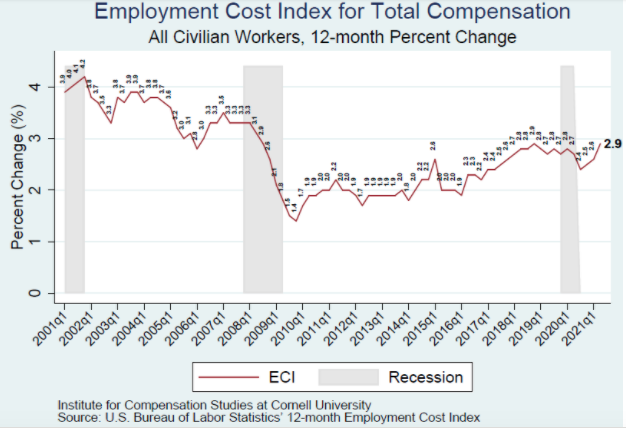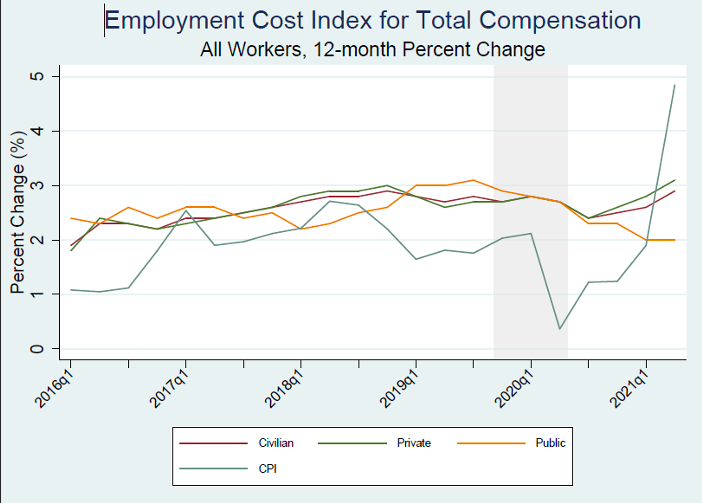
2021 Second Quarter
2021 Second Quarter: Annual compensation growth strengthens further, with largest increases for wages and salaries for private-sector workers in service occupations
Civilian workers compensation costs 12-month growth rate of 2.9 percent growth per year matches the pre-pandemic growth
Released July 30, 2021, the U.S. Bureau of Labor Statistics’ 12-month Employment Cost Index (ECI) in the first quarter of 2021 ticked up to 2.9 percent (Chart 1), the highest growth rate since Q4 2018. ECI growth had hovered between 2.7 and 2.9 percent for the 10 quarters (from Q1 2018 through Q2 2020) before the pandemic and decreased to 2.4 percent in September 2020. Prior to that, ECI growth accelerated steady between 2016 Q2 and 2017 Q4 as the labor market tightened. Yet, behind this relatively stable trend lies an unusually high degree of variation over the year and among groups.
Chart 1

Data sources: U.S. Bureau of Labor Statistics, Employment Cost Index and Consumer Price Index.
2021 Q2 12-month ECI growth concentrated in the private sector, and less than recent inflation
Recent compensation increases have been concentrated in the private sector. Government compensation cost growth has been declining as private compensation costs growth has increased. Wage and salary growth was 3.2 percent over the 12-month period, the highest rate since Q4 2008. At the same time, price inflation has been rising. Thus, as of Q2 2021, 12-month increases in consumer prices were much higher than compensation costs increases, especially for government workers. Thus, workers’ real earnings lost ground.
Chart 2

Data sources: U.S. Bureau of Labor Statistics, Employment Cost Index and Consumer Price Index.
Private sector compensation rises while public sector compensation growth is flat
Breaking total compensation into its key components of earnings (wages and salaries) and benefits, total benefits typically account for about 30 percent of employer costs for employee total compensation. Table 1 reports the ECI trends for each of these categories by public and private sector. The recent slower growth in compensation is due to slower wage and salary growth. At 2.5 percent over the last 12 months, benefits growth exceeded the range between 2.1 to 2.3 percent that prevailed for seven quarters (since Q2 2019). With the exception of only one quarter –Q2 2017—earnings have been growing faster than benefits since Q2 2015.
The table also shows that public and private sector compensation components moved quite differently over the past year. Public sector compensation costs slowed more during the pandemic than private sector compensation and have yet to show recovery.
In the private sector, comparing the 12 months ending in June 2020 with the 12 months ending in June 2021, we see a notable pick-up in wage and salary growth (from 2.9 percent from 3.5 percent—the highest growth rate since March 2007) while benefits costs growth were unchanged at 2.0 percent.
By contrast, both components of public sector compensation grew much more slowly in the recent period. Comparing the 12 months ending in June for 2020 and 2021, wage and salary growth declined from 2.6 percent to 1.5 percent and benefits cost growth slowed from 3.1 percent to 2.6 percent.
Table 1
|
Major series of the Employment Cost Index [Percent change] |
||||||
|
Category |
12-month, not seasonally adjusted |
|||||
|
Jun. |
Sep. |
Dec. |
Mar. |
Jun. |
||
|
Civilian workers (1) |
||||||
|
Compensation (2) |
2.7 |
2.4 |
2.5 |
2.6 |
2.9 |
|
|
Wages and salaries |
2.9 |
2.5 |
2.6 |
2.7 |
3.2 |
|
|
Benefits |
2.2 |
2.3 |
2.1 |
2.5 |
2.2 |
|
|
Private industry |
||||||
|
Compensation (2) |
2.7 |
2.4 |
2.6 |
2.8 |
3.1 |
|
|
Wages and salaries |
2.9 |
2.7 |
2.8 |
3.0 |
3.5 |
|
|
Benefits |
2.0 |
2.0 |
2.1 |
2.5 |
2.0 |
|
|
State and local government |
||||||
|
Compensation (2) |
2.7 |
2.3 |
2.3 |
2.0 |
2.0 |
|
|
Wages and salaries |
2.6 |
1.8 |
1.8 |
1.6 |
1.5 |
|
|
Benefits |
3.1 |
3.2 |
3.1 |
2.6 |
2.6 |
|
Footnotes
(1) Includes private industry and state and local government.
(2) Includes wages and salaries and benefits.
Prepared by Cornell Institute for Compensation StudiesTM
Data Source: BLS (ECI Historical Listing, July 30, 2021)
Private sector 12-month compensation growth varies widely by occupation
Private sector compensation growth varied strongly among occupational groups (see Chart 3), likely reflecting a high degree of pandemic-related flux in labor supply and demand conditions. Indeed, the standard deviation of growth rates by major occupational group is the highest since this series began in 2001. Over the last 12 months, earnings grew slowest (2.4 percent) for professional and managerial occupations and twice as fast for service occupations (4.8 percent).
Chart 3

Prepared by Cornell Institute for Compensation StudiesTM
Data Source: US Bureau of Labor Statistics Employment Cost Index
The Employment Cost Index (ECI) released July 30, 2021 by the U.S. Bureau of Labor Statistics reflects trends in the costs to employers for the total compensation, wages, and benefits they provide to their workers, controlling for composition of the workforce. The ECI is one of the labor market indicators used by the Federal Reserve Board to monitor the effects of fiscal and monetary policies and is released quarterly. The BLS summary can be found at https://www.bls.gov/news.release/eci.nr0.htm.



